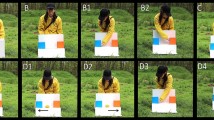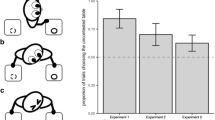Abstract
Visual perspective taking (VPT), an understanding of what others can see, is a prerequisite for theory of mind (ToM). While VPT in apes is proven, its presence in monkeys is much-debated. Several different paradigms have been developed to test its existence, but all face interpretational problems since results can be explained by simpler cognitive mechanisms than VPT. Therefore, we adjusted one method where two individuals compete for access to food, visible or invisible for the dominant competitor, to preclude cognitively simpler mechanisms. The subordinate long-tailed macaques tested, selected significantly more often the food item invisible than the item visible to the dominant. In most trials, subjects retrieved only one food item and preferred the invisible food item. Surprisingly, they occasionally adopted an alternative strategy to obtain both food items, by first choosing the visible, most at risk food item. Faster animals adopted this strategy proportionally more often than slower ones. Contrary to previous research, our results cannot be explained by simpler cognitive mechanisms, since behavioural reading was prevented by a one-way mirror between the competitor and the food, and accessibility was equal to both food items. This is the first unequivocal evidence of VPT in a monkey species, suggesting that this precursor to ToM is an evolutionarily conserved capacity present in monkeys, apes and humans.




Similar content being viewed by others
References
Amici F, Visalberghi E, Aureli F, Call J (2009) Spider Monkeys (Ateles geoffroyi) and Capuchin Monkeys (Cebus apella) follow gaze around barriers: evidence for perspective taking? J Comp Psychol 123(4):368–374. doi:10.1037/a0017079
Bergstrom ML, Fedigan LM (2010) Dominance among female white-faced capuchin monkeys (Cebus capucinus): hierarchical linearity, nepotism, strength and stability. Behaviour 147:899–931
Burkart J, Heschl A (2006) Geometrical gaze following in common marmosets (Callithrix jacchus). J Comp Psychol 120(2):120–130. doi:10.1016/j.anbehav.2006.05.019
Burkart JM, Heschl A (2007) Understanding visual access in common marmosets, Callithrix jacchus: perspective taking or behaviour reading? Anim Behav 73:457–469. doi:10.1016/j.anbehav.2006.05.019
Call J, Tomasello M (2008) Does the chimpanzee have a theory of mind? 30 Years later. Trends Cognit Sci 12(5):187–192. doi:10.1016/j.tics.2008.02.010
de Vries H (1995) An improved test of linearity in dominance hierarchies containing unknown or tied relationships. Anim Behav 50:1375–1389
de Vries H (1998) Finding a dominance order most consistent with a linear hierarchy: a new procedure and review. Anim Behav 55:827–843
de Vries H, Netto WJ, Hanegraaf PLH (1993) Matman—a program for the analysis of sociometric matrices and behavioral transition matrices. Behaviour 125:157–175
de Waal FBM (1997) Food transfers through mesh in brown capuchins. J Comp Psychol 111(4):370–378. doi:10.1037/0735-7036.111.4.370
Goossens BMA, Dekleva M, Reader SM, Sterck EHM, Bolhuis JJ (2008) Gaze following in monkeys is modulated by observed facial expressions. Anim Behav 75:1673–1681. doi:10.1016/j.anbehav.2007
Goossens BMA, van den Berg LM, Reader SM, Sterck EH (2012) An analysis of gaze following to a hidden location in long-tailed macaques (Macaca fascicularis). Behaviour 149:1319–1337
Hare B, Call J, Agnetta B, Tomasello M (2000) Chimpanzees know what conspecifics do and do not see. Anim Behav 59:771–785
Hare B, Addessi E, Call J, Tomasello M, Visalberghi E (2003) Do capuchin monkeys, Cebus apella, know what conspecifics do and do not see? Anim Behav 65:131–142. doi:10.1006/anbe.2002.2017
Hare B, Call J, Tomasello M (2006) Chimpanzees deceive a human competitor by hiding. Cognition 101(3):495–514. doi:10.1016/j.cognition.2005.01.011
Hermann E, Call J (2012) Are there geniuses among the apes? Philos Trans R Soc B Biol Sci 367(1603):2753–2761. doi:10.1098/rstb.2012.0191
Itakura S (2004) Gaze-following and joint visual attention in nonhuman animals. J Psychol Res 46(3):216–226. doi:10.1111/j.1468-5584.2004.00253.x
Kummer H, Cords M (1991) Cues of ownership in long-tailed macaques, Macaca fascicularis. Anim Behav 42:529–549
Melis AP, Call J, Tomasello M (2006) Chimpanzees (Pan troglodytes) conceal visual and auditory information from others. J Comp Psychol 120(2):154–162. doi:10.1037/0735-7036.120.2.154
R Development Core Team (2009) R: a language and environment for statistical computing. R Foundation for Statistical Computing, Vienna
Reader SM, Hager Y, Laland KN (2011) The evolution of primate general and cultural intelligence. Philos Trans R Soc B Biol Sci 366(1567):1017–1027. doi:10.1098/rstb.2010.0342
Scerif G, Gomez J, Byrne RW (2004) What do Diana monkeys know about the focus of attention of a conspecific? Anim Behav 68:1239–1247. doi:10.1016/j.anbehav.2004.01.011
Schaffner CM, Caine NG (2000) The peacefulness of cooperatively breeding primates. In: Aureli F, De Waal FBM (eds) Conflict resolution. University of California press, California, pp 155–169
Sterck EHM, Begeer S (2010) Theory of mind: specialized capacity or emergent property? Eur J Dev Psychol 7(1):1–16
Sueur C, Petit O, De Marco A, Jacobs AT, Watanabe K, Thierry B (2011) A comparative network analysis of social style in macaques. Anim Behav 82(4):845–852. doi:10.1016/j.anbehav.2011.07.020
Thierry B (2004) Social epigenesis. In: Thierry B, Singh M, Kaumanns W (eds) Macaque societies: a model for the study of social organization. Cambridge University Press, Cambridge, pp 267–289
Tomasello M, Call J, Hare B (1998) Five primate species follow the visual gaze of conspecifics. Anim Behav 55:1063–1069. doi:10.1006/anbe.1997.0636
Tomasello M, Hare B, Agnetta B (1999) Chimpanzees, Pan troglodytes, follow gaze direction geometrically. Anim Behav 58:769–777. doi:10.1006/anbe.1999.1192
Triesch J, Teuscher C, Deak GO, Carlson E (2006) Gaze following: why (not) learn it? Dev Sci 9(2):125–147. doi:10.1111/j.1467-7687.2006.00470.x
Vernes MK, Louwerse AL (2010) BPRC’s enrichment manual for macaques & marmosets. Biomedical Primate Research Centre, Rijswijk
Acknowledgments
We would like to thank Maaike Berdowski for her assistance during the experiment and the animal caretakers for their care for the monkeys. We thank two anonymous referees for their thoughtful comments and Han de Vries for statistical advice. This research was funded by the Biomedical Primate Research Centre, Rijswijk, the Netherlands.
Ethical statement
This study was carried out in accordance with the legal requirements of the Netherlands. This research was approved by the Animal Ethical Committee of the Biomedical Primate Research Centre. Subjects were trained by positive reinforcement to be temporarily separated from their group members in part of their home cage. Outside testing hours, monkeys were fed monkey chow accomplished with fruit, vegetables or bread in front of the test cage. Water was available at libitum. Monkeys received permanent environmental enrichment, and extra enrichment containing food was provided every other week (Vernes and Louwerse 2010).
Conflict of interest
The authors declare that they have no conflict of interest.
Author information
Authors and Affiliations
Corresponding author
Rights and permissions
About this article
Cite this article
Overduin-de Vries, A.M., Spruijt, B.M. & Sterck, E.H.M. Long-tailed macaques (Macaca fascicularis) understand what conspecifics can see in a competitive situation. Anim Cogn 17, 77–84 (2014). https://doi.org/10.1007/s10071-013-0639-6
Received:
Revised:
Accepted:
Published:
Issue Date:
DOI: https://doi.org/10.1007/s10071-013-0639-6




